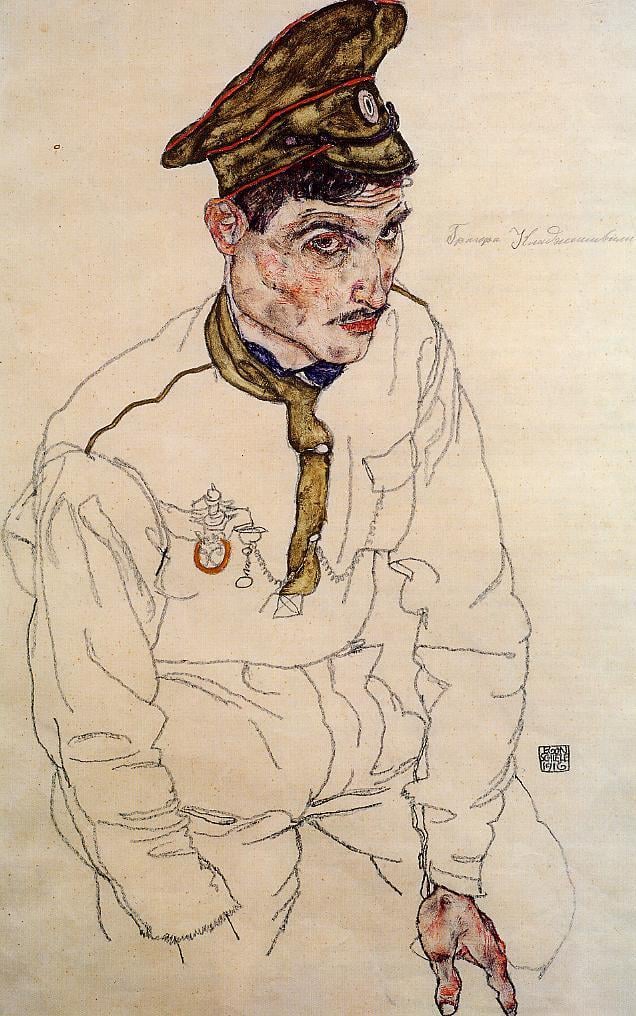
The office of Manhattan District Attorney Alvin Bragg has filed an order containing arguments for the Art Institute of Chicago to turn over a work by Egon Schiele that was looted by Nazis.
Matthew Bogdanos, an assistant district attorney and retired U.S. Marine Corps colonel who served in Afghanistan, penned an expansive 160-page application for a turnover order, filed in the New York Supreme Court on Friday. Though the document refers to “a warrant to search the premises located at the Art Institute of Chicago,” the latest order lays out the prosecutors’ case for why it should be returned. The work remains seized-in-place at the museum, which said is best suited to care for and protect it.
Still, it is the latest development in ongoing disputes between the heirs of Fritz Grünbaum and various institutions in the United States and Europe. The heirs are seeking to recover more than 80 works the Austrian Jewish performer was forced to hand over to the Nazis when he was imprisoned in 1938, before his murder at the Dachau concentration camp in 1941. Many of those works entered the art market and have since ended up in international museums, the heirs say.
The warrant seeks the return of a drawing by Schiele, titled Russian War Prisoner (1916), to Grünbaum’s heirs: Timothy Reif, David Fraenkel and Milos Vavra. The DA’s office describes the work as part of an active criminal investigation into a network smuggling Nazi-looted art from Europe through New York.
The document makes a number of major revelations as prosecutors painstakingly described how works looted by the Nazis were trafficked into the United States through a conspiracy prosecutors say primarily involved Eberhard Kornfeld—the operator of a Swiss auction house who died in April 2023—and Otto Kallir, the late operator of a gallery in New York who died in 1978.
The portrayal of Kallir as part of the conspiracy is particularly surprising, as he was long celebrated as the “savior” of works by Austrian and German artists who were labelled as “degenerate” by Adolf Hitler, such as Schiele. He also helped the heirs of Holocaust victims seeking recover their family’s art after the war, including Schiele’s famous “Portrait of Wally.”
Bogdanos outlined that the sweeping investigation began in December 2022 when he was contacted by Reif, a federal judge on the United States Court of International Trade. Grünbaum was Reif’s great-uncle. Bogdanos met with Reif and his counsel on December 9, 2022, and initially determined there were 11 Schiele drawings from Grünbaum’s collection known to have been owned, displayed or sold in New York.
The Antiquities Trafficking Unit of the district attorney’s office convened a grand jury and officially opened the investigation on December 22, 2022. Since then, 10 drawings have been legally seized as stolen and another was surrendered. Seven of those were returned in September 2023 and another two in January. Russian War Prisoner is the 10th, previously “seized” but not in the possession of authorities.
Following similar procedures for the restitution of the other drawings, Bogdanos said he contacted the museum’s lawyer and served it with a letter of retention asking it to voluntarily retain and safeguard the drawing. The museum agreed to do so, pending the outcome of the investigation, he said.
Beginning in May 2023, Bogdanos said he had multiple meetings with the museum about evidence gathered that allegedly shows Russian War Prisoner was stolen. And in September, the Antiquities Trafficking Unit was granted a warrant for the seizure of the work—the same warrant referred to in the latest order.
The Art Institute requested that the work instead be seized in place, meaning it would temporarily remain in the museum’s possession for 60 days. The museum soon after sought an extension of that request, to which prosecutors consented while waiting to file the turnover order. The museum will now have a chance to respond over the next couple months leading up to oral arguments in the spring.
The museum previously notified authorities in September that it would contest the return of the drawing, after prosecutors said they planned to return it to Grünbaum’s heirs. Prosecutors are now seeking to physically obtain the drawing. The museum asserts that it continues to comply with authorities.
To establish ownership of the drawing, the court document contains extensive background information on Grünbaum, his wife Elisabeth, and their family history.
And though Kornfeld and Kallir—who was Jewish himself—are deceased and cannot be prosecuted for any alleged crimes, authorities document how they knew the work belonged to Grünbaum but still sought to profit from the stolen work. Kallir purchased many of the Schiele drawings the Nazis had stolen from Grünbaum through Kornfeld, the DA’s office explained, and they were then sold through his Galerie St. Etienne.
“We have done extensive research on the provenance history of this work and are confident in our lawful ownership of the piece,” Megan Michienzi, the executive director of public affairs at the museum, said in an email. “Federal court has explicitly ruled that the Grünbaum’s Schiele art collection was ‘not looted’ and ‘remained in the Grünbaum family’s possession’ and was sold by Fritz Grünbaum’s sister-in-law Mathilde Lukacs in 1956. If we had this work unlawfully, we would return it, but that is not the case here.”